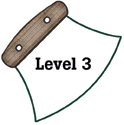|
National Science Education Standards
Populations of organisms can be categorized by the function they serve
in an ecosystem. Plants and some microorganisms are producers–they
make their own food. All animals, including humans, are consumers, which
obtain food by eating other organisms. Decomposers, primarily bacteria
and fungi, are consumers that use waste materials and dead organisms for
food. Food webs identify the relationships among producers, consumers,
and decomposers in an ecosystem. (Page 157)
For ecosystems, the major source of energy is sunlight. Energy entering
ecosystems as sunlight is transferred by producers into chemical energy
through photosynthesis. That energy then passes from organism to organism
in food webs. (Page 158)
The number of organisms an ecosystem can support depends on the resources
available and abiotic factors, such as quantity of light and water, range
of temperatures, and soil composition. Given adequate biotic and abiotic
resources and no disease or predators, populations (including humans)
increase at rapid rates. Lack of resources and other factors, such as
predation and climate, limit the growth of populations in specific niches
in the ecosystem. (Page 158)
|
|
Benchmarks
Food provides molecules that serve as the fuel and the building material
for all organisms. Plants use the energy from light to make sugars from
carbon dioxide and water. This food can be used immediately or stored
for later use. Organisms that eat plants break down the plant structures
to produce the materials and energy they need to survive. (Page 120)
Over a long time, matter is transferred from one organism to another
repeatedly and between organisms and their physical environment. As in
all material systems, the total amount of matter remains constant, even
though its form and location change. (Page 120)
Energy can change from one form to another in living things. Animals
get energy from oxidizing their food, releasing some of its energy as
heat. Almost all food energy comes originally from sunlight. (Page 120)
|


